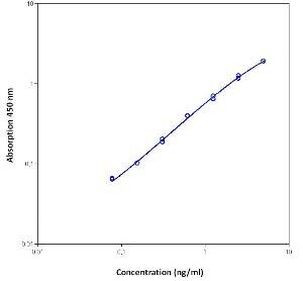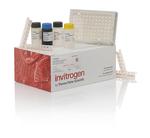Search Thermo Fisher Scientific
Product Specifications
Analytical sensitivity
Assay range
Sample type/volume
Hands-on time
Time-to-result
Homogenous (no wash)
Interassay CV
Intraassay CV
Instrument
Product size
Contents
Detection Antibody
Anti-IgG-HRP
Sample Diluent, lyophilized
Standard (8-well strips x 4)
Wash Buffer Concentrate
Substrate Solution
Sample Diluent
Stop Solution
Lysis Buffer 10x
Adhesive Plate Covers
Shipping conditions
Storage
Protein name
Target sub-specificity
Species (tested)
Assay kit format
Detector antibody conjugate
Label or dye
About This Kit
The Human Soluble Tumor Necrosis Factor Receptor 1(Hu sTNRF1) ELISA quantitates Hu sTNFR1 in human serum, plasma, cell culture supernatants, or other body fluids. The assay will exclusively recognize both natural and recombinant Hu sTNFR.
Principle of the method
The Human sTNFR1 solid-phase sandwich ELISA (enzyme-linked immunosorbent assay) is designed to measure the amount of the target bound between a matched antibody pair. A target-specific antibody has been pre-coated in the wells of the supplied microplate. Samples or controls are then added into these wells and bind to the immobilized (capture) antibody. The sandwich is formed by the binding of the second (detector) antibody to the target on a different epitope from the capture antibody. An antibody conjugated with enzyme binds the formed sandwich. After incubation and washing steps to rid the microplate of unbound substances, a substrate solution is added that reacts with the enzyme-antibody-target complex to produce measurable signal. The intensity of this signal is directly proportional to the concentration of target present in the original specimen.
Rigorous validation
Each manufactured lot of this ELISA kit is quality tested for criteria such as sensitivity, specificity, precision, and lot-to-lot consistency. See manual for more information on validation.
TNFR1 (Tumor necrosis factor receptor 1) belongs to the tumor necrosis factor superfamily, and is one of the major TNF-alpha receptors. TNFR1 plays an important role in mediating, in cytokine mediated signaling, positive regulation of the NF-Kb pathway, positive regulation of angiogenesis, and negative regulation of gene expression. The extracellular domain of TNFR1 is also released into the circulatory system as soluble TNFR1 (sTNFR1). In humans, the TNFR1 gene is located on chromosome 12. Anti-apoptotic protein BCL2-associated athanogene 4 (BAG4/SODD) and adaptor proteins TRADD and TRAF2 have been shown to interact with TNFR1, and thus play regulatory roles in the signal transduction mediated by the receptor. Germline mutations of the extracellular domains of TNFR1 were found to be associated with the autosomal dominant periodic fever syndrome, and the impaired receptor clearance is thought to be a mechanism of the disease.
For Research Use Only. Not for use in diagnostic procedures. Not for resale without express authorization.
References (0)
Bioinformatics
Gene aliases : CD120a, FPF, MS5, p55, p55-R, p60, TBP1, TNF-R, TNF-R-I, TNF-R55, TNFAR, TNFR1, TNFR1-d2, TNFR55, TNFR60, TNFRSF1A
Gene ID : (Human) 7132
Gene symbol : TNFRSF1A
Protein Aliases : CD120a, p55, p60, TNF-R1, TNF-RI, TNFR-I, tumor necrosis factor binding protein 1, Tumor necrosis factor receptor 1, tumor necrosis factor receptor 1A isoform beta, Tumor necrosis factor receptor superfamily member 1A, tumor necrosis factor receptor superfamily, member 1A, tumor necrosis factor receptor type 1, Tumor necrosis factor receptor type I, tumor necrosis factor-alpha receptor
UniProt ID (Human) P19438

Performance Guarantee
If an Invitrogen™ antibody doesn't perform as described on our website or datasheet,we'll replace the product at no cost to you, or provide you with a credit for a future purchase.*
Learn more
We're here to help
Get expert recommendations for common problems or connect directly with an on staff expert for technical assistance related to applications, equipment and general product use.
Contact tech support


